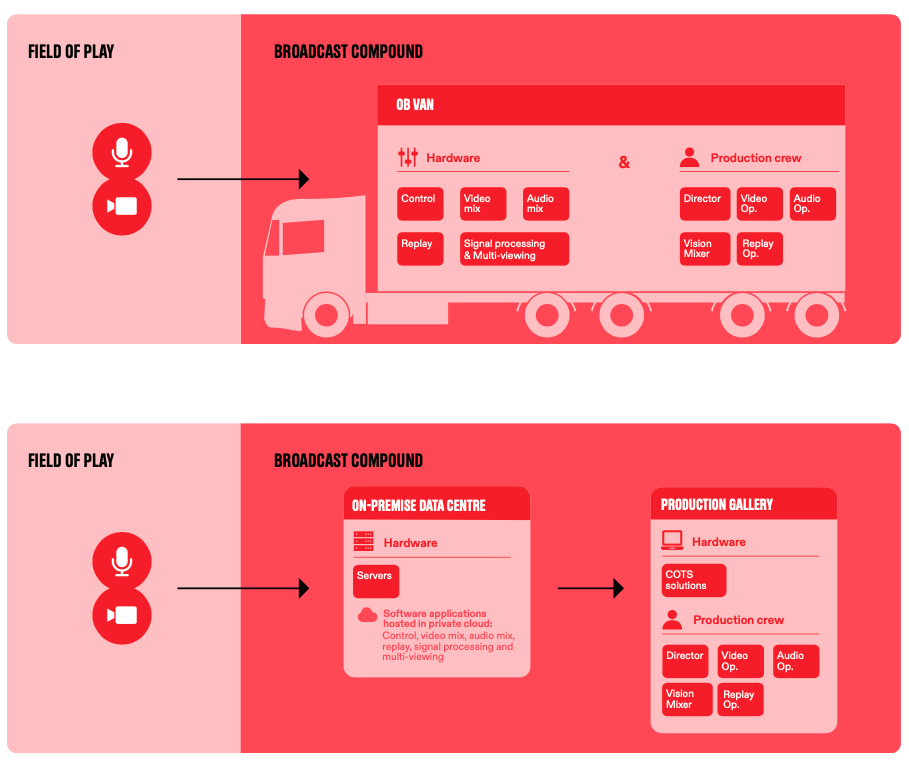
OBS, Olympic Broadcast Services, is the outfit in charge of making sure the 2022 Beijing Winter Olympics gets to the world’s screens. This is how they do it.
Every major sports and live event has its own host broadcaster and, in recent years, the trend has been to establish a specific one for each major event. That guarantees consistency of coverage and a base level of technical assurance that things will not go wrong. Your NBCs, BBCs, and Eurosports do their own thing with their own teams, but they’re restricted to interviews, panellists, anchors and the like. The footage of the event itself is always provided by the host.
HBS does the World Cup, UEFA set up its own outfit to oversee the Euros, Formula One has been producing its own coverage since 2004 partly to prevent viewer frustration at watching the local director follow a local driver around at the back of the field, and Olympic Broadcast Services (OBS) is the outfit in charge of the Olympics.
OBS’ first games were the Beijing 2008 Summer Olympics, so in a sense it’s returning full circle. What is unusual though is the truncated timeframe between its last major gig in Tokyo over the summer. Usually it has around 18 months to prep between events, but the Covid delays that hit the Summer Games have shrunk this to six and it’s had to move very fast and be very agile as a result. A lot of equipment basically ended up being shipped straight from Japan to China, as it could not take the risk of relying on the creaking global supply chain to get it first home and then back to where it needed to be in time.
The Winter Olympics by the numbers
First off, some stats.
- Hours of content: 6000+
- HD distribution feeds: 43
- UHD distribution feeds: 36
- Camera systems: 660+
- Speciality cameras:148
- High-speed slo mo cameras: 38
- OB vans: 15
- Cable: 8684km
- Bandwidth: 1.7Tbps
- Workforce: 4300+
So, what’s new this time around?
To begin with there is a lot more cloud production than ever before. OBC reckons that the distribution of live signals via the cloud will match that of conventional delivery models, helped in part by the massive 1.7Tbps pipe that has been booked by the various broadcasters. Compare that to the 500Gbps booked for the last Winter Olympics in South Korea in 2018 and you can see the difference in scale.
There is a lot of this sort of thing going on. The curling tournament is going to be produced in a production gallery in the compound using COTS computer kit (Commercial Off-The Shelf) running virtualised software. OBS is referring to this as a virtualised OB van and four additional native IP cameras will be connected to the network stack, eliminating the need for camera control units entirely.
 Pic: OBS
Pic: OBS
This is a significant project and one that a lot of other sports production companies around the world are going to be looking at. The end game ambition is basically to only have cameras, mics and their operators heading out to sports venues, plugging into a truck, and everything else happening back at base.
“Our idea is that in the near future, we will be able to replace the use of typical OB vans or bespoke flight pack systems, with a standardised ICT architecture of COTS servers and IP switchers, where all standard broadcast applications for live production will be only software functions,” comments OBS’ Sotiris Salamouris. “This will offer us tremendous flexibility in order to address the major problem of having to deal with so many different systems, like individual production units with each one of them based on a different combination of broadcast boxes which themselves require specialised configurations and overall handling.”
Technology experiments
5G is a part of the curling project too and will be used out on the alpine and cross country skiing events. About 30 5G cameras will be deployed, and if that seems slightly less than might have once been thought, especially given the live of 5G hype in the broadcast industry at the moment, then it’s an indication of the technical problems the technology still faces in real world solutions. For example, OBS has mounted a 54G camera on a snowmobile to follow the cross country skiing, but needs to find a way to manage the amount of latency that the handover from cell to cell may introduce into the system as it moves locations, making cutting between tethered and 5G cameras nigh on impossible.
Another zeitgeist favourite, AI, is also going to be used comparatively sparingly and primarily to create clips from the figure skating and ice hockey events, which will be shared with OBS producers to edit highlights packages and music pieces.
A new base spec
Considering that OBS first started experimenting with it in 2012, 8K is also in fairly sparse attendance. OBS is collaborating with Japan’s NHK and the China Media Group to provide 8K coverage from selected competition venues and the National Stadium for Ceremonies, but only about 70 hours of live coverage in total. Indeed, its main focus with the format seems to be increasingly with VR, and together with Intel, it is planning to capture, produce and distribute some live content in 8K VR for any broadcasters who want it, as well as letting them use these VR feeds in 8K to create virtual backdrops for their television studios.
The main thrust though is UHD HDR. This is the first Winter Games to be produced natively in the format with additional 5.1.4 audio, but to make that work OBS had to develop a single HDR to SDR production workflow model that will allow the trucks to generate an HD 1080i output via high-quality conversion from the primary UHD HDR signal.
The reason is that the majority of broadcasters are yet to carry UHD. They also have to upconvert for the minority that do though as several of the speciality cameras can only currently output at HD 1080p SDR. That means the video source of these cameras must be up-converted on the fly to UHD HDR in order to be seamlessly integrated into the main production so that there are no perceived colour or brightness differences. Luckily, the OBS team has developed a set of LUTs in-house to maximise the quality between all cross-conversions, so all should proceed smoothly.
Will there be more 8K at the next Summer Games in Paris? Currently it’s not looking likely. The big thrust is moving workflows into the cloud, which OBS sees as providing flexibility and scale, while minimising footprint and increasing sustainability is an ever-more crucial component of the company’s thinking.
“Thanks to virtualisation, hardware is now utilised to levels up to or more than 90%, a level that was unthinkable with previous approaches that were only relying on physical servers for running the applications software,” writes Salamouris. “The cloud is the next step as it holds the highest possible density in terms of virtualised assets, together with a highly sophisticated and rich set of tools that allow the just-in-time use and
management of this tremendous concentration of computational and networking capacity. There is not a more efficient manner to run applications of any sort.”


Comments